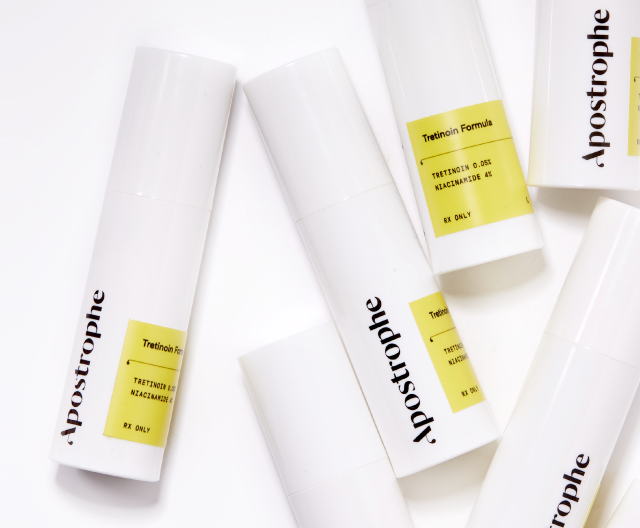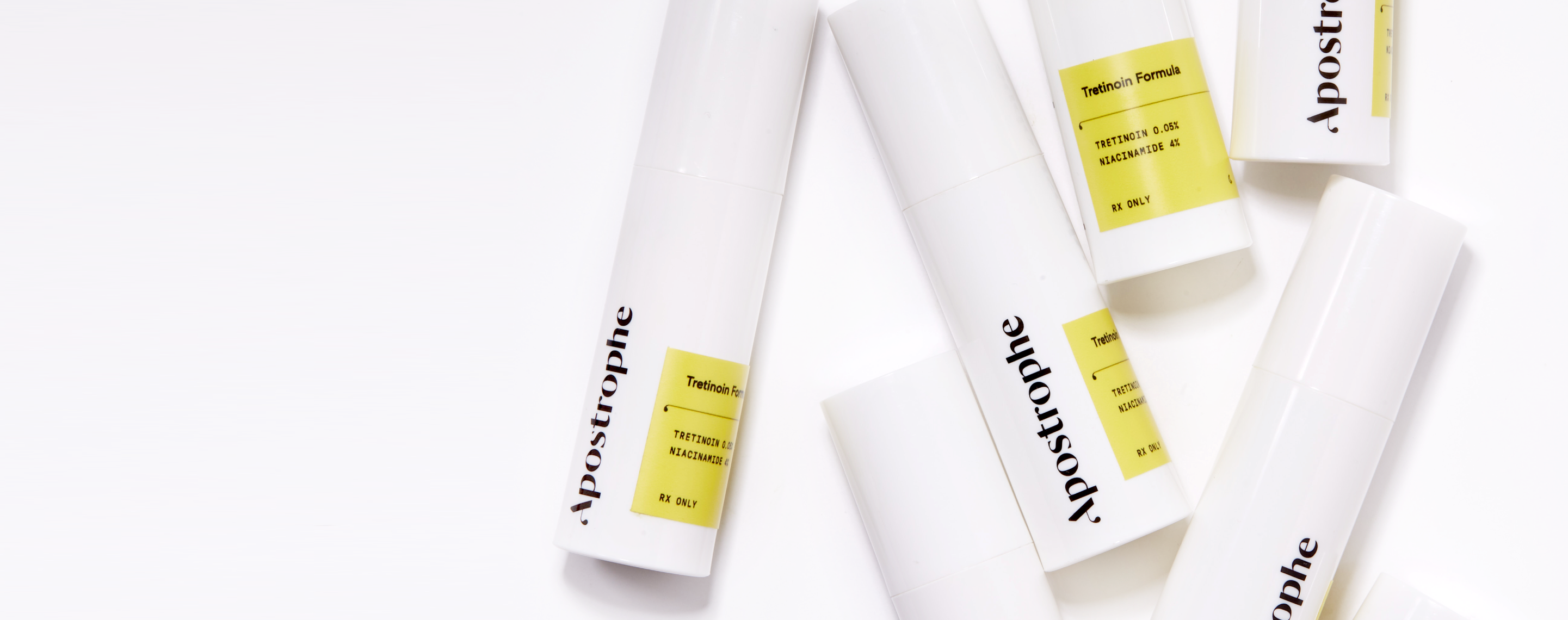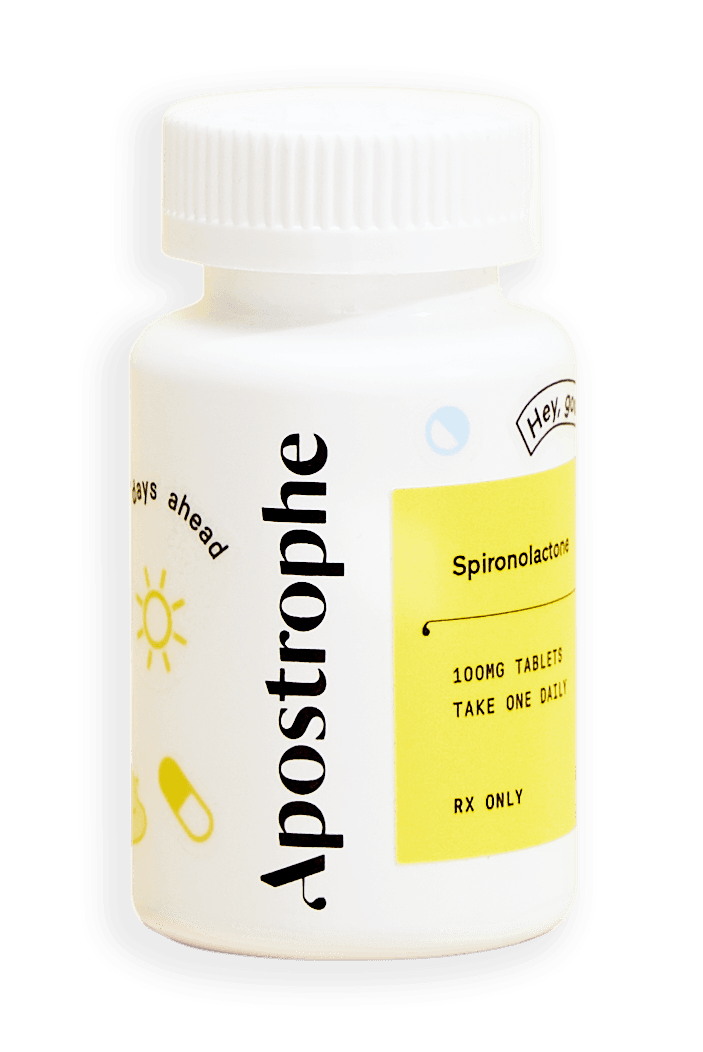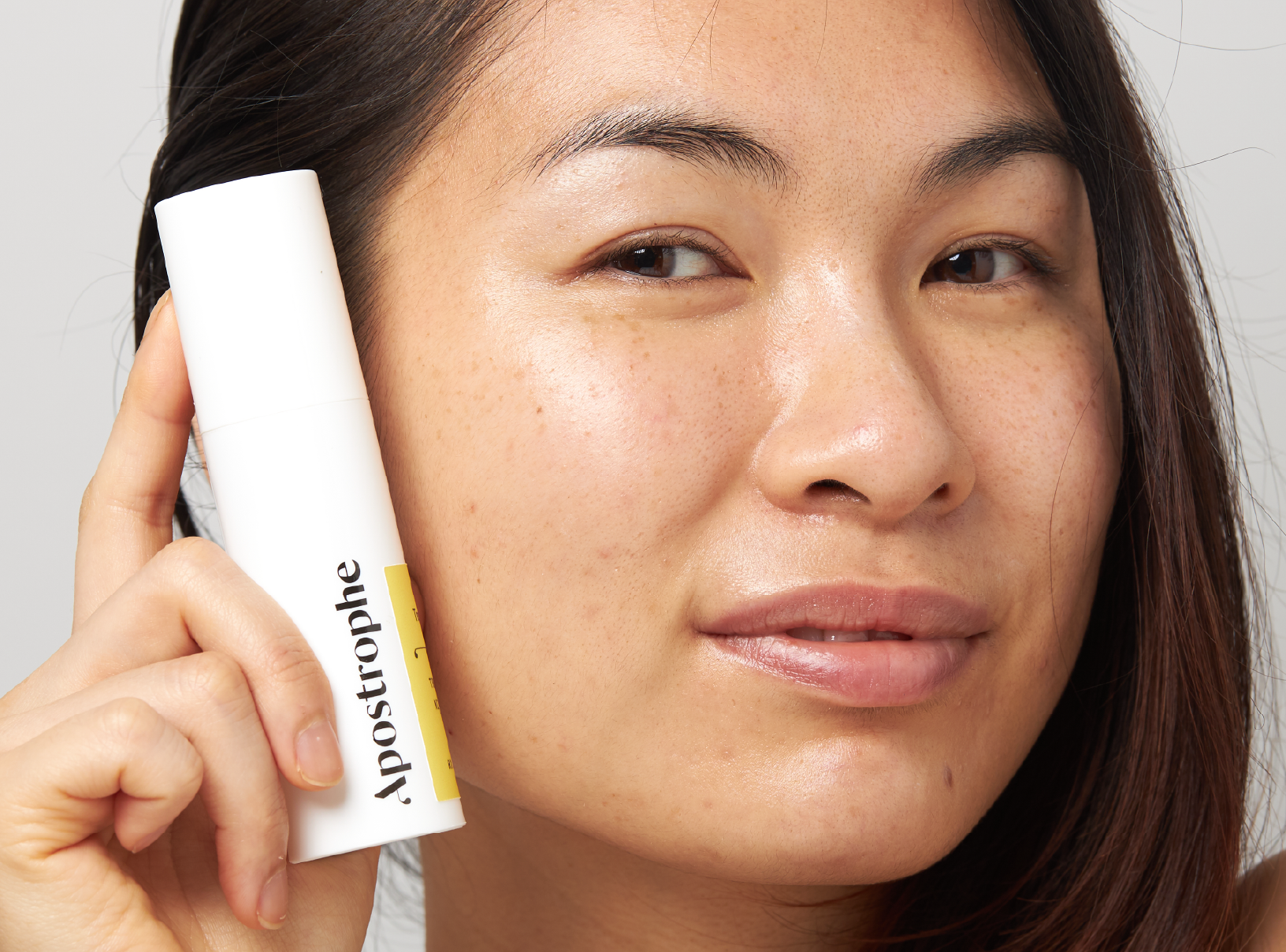Education
Does Tretinoin Treat Hormonal Acne?


SHARE
Education
Does Tretinoin Treat Hormonal Acne?
Medically reviewed by Aimee Paik, MD
Written by Apostrophe Team
Last updated 1/6/2023
Does Tretinoin Treat Hormonal Acne?
You’ve tried the ABCs of acne-fighting medications: Alpha-hydroxy acids, Beta-hydroxy acids, and Cleansers galore. Still, nothing seems to conquer the angry, red hormonal acne covering your chin and jawline.
If you know this story all too well, it’s time to bring out the big guns: tretinoin, or ‘tret’ as true skincare aficionados call it.
Does tretinoin work as a hormonal acne treatment? While it doesn’t directly target hormonal fluctuations, it can be combined with other therapies to address hormonal acne effectively. We’ll give you a full breakdown of how tretinoin for hormonal acne works, what else you can try, and, most importantly, when you can expect to see results!
How Tretinoin Works
Let’s start with the basics. What exactly is this skincare miracle? Dermatologists have been successfully using this Vitamin A derivative since the 1970s for acne treatment. Because tretinoin has been FDA approved for almost 50 years, it has amassed considerable efficacy and safety data in the treatment of both acne and photodamaged (sun-damaged) skin.
Tretinoin’s formal name is all-trans retinoic acid. It can be derived from natural Vitamin A. Two synthetic retinoids are also used to treat acne. These are:
Adapalene
Tazarotene
However, these synthetic retinoids bind differently to the receptors in the skin, leading to differing clinical efficacy.
This little acid has some big powers. Tretinoin can modify:
Gene expression
Protein synthesis
Epithelial cell growth and differentiation
If you don’t have a Bachelor’s in Chemistry, no worries. We’ve got you covered. Basically, when tretinoin binds with the retinoid receptors in your skin cells, it increases the turnover rate of those skin cells. As a result, tretinoin has a wide range of favorable effects, but we’ll focus on the ones that relate to acne:
Helps keep pores unclogged
Stimulates new collagen
Reduces inflammation
Prevents collagen loss
Reduces pigmentation
A large number of clinical studies has shown that tretinoin reduces the total number of pimples as well as overall inflammation. It also helps prevent future acne because it induces a higher turnover rate in your skin cells, keeping your pores free of dead skin and excess oil.
Many people love tretinoin because, in addition to treating acne, it also reduces clinical signs of photodamage (aka aging from sun exposure) such as:
Fine lines
Coarse wrinkles
Hyperpigmentation
Roughness or uneven skin texture
Think of tretinoin as the ultimate BOGO deal. It can treat acne and reduce signs of aging all at once! You’re probably starting to understand why tretinoin is a favorite anti-aging and anti-acne tool among almost every dermatologist.
Is Tretinoin the Same as Retinol?
Take a trip to the drugstore, and you might notice many skin care products boasting the title “retinol.” What’s up with that?
Well, tretinoin is a retinoid.
Both retinoids (like tretinoin) and retinol are Vitamin A derivatives that convert into retinoic acid.
Many over-the-counter skin care products contain retinol.
However, a significant difference between tretinoin vs retinol is that retinol is available without a prescription because it is significantly weaker than retinoids like tretinoin.
In contrast, tretinoin is stronger and more effective but requires a prescription. However, you can get a tretinoin prescription online.
Does Tretinoin Work for Hormonal Acne?
We have almost fifty years of studies to confirm that tretinoin for acne works, but does tretinoin work for hormonal acne? The answer is yes, but it’s also complicated, so let’s break down what exactly hormonal acne is.
In their twenties, 50% of women battle adult acne versus just 40% of men. In their thirties, 35% of women battle acne versus only 20% of men.
Pink tax, gender pay gap, and more acne?! Let’s get down to the bottom of this blemish gap.
The American Academy of Dermatology explains that women are more likely to experience adult acne because of their hormonal fluctuations. Basically, women’s hormones are always in flux. Some major causes include:
Pregnancy
Perimenopause
Menopause
However, you don’t have to undergo a significant life change to shift your hormonal levels. Each month, the different phases of the menstrual cycle cause constant hormonal fluctuations that can lead to acne. Starting and stopping birth control pills can also cause a temporary acne-inducing hormonal imbalance.
How exactly do your hormones wreak havoc on your face, you ask? It’s time to talk about androgens.
You’ve probably heard of testosterone. Like testosterone, androgens are male sex hormones found in both men and women at different levels.
Androgens are responsible for many of the distinct characteristics of biological males, also like testosterone.
Outside of their day job as a male sex hormone, androgens play a key role in regulating oil production in your skin.
Hormonal fluctuations and imbalances lead to an increase in androgens. Androgens and excess oiliness can both contribute to clogged pores, making a perfect recipe for hormonal breakouts.
If this increase in androgens is pathological, it’s referred to as hyperandrogenism. Women with polycystic ovary syndrome (PCOS) often suffer from hyperandrogenism and, subsequently, hormonal acne.
So does tretinoin work for hormonal acne? As with all other forms of acne, tretinoin prevents breakouts by instructing your skin cells to shed more quickly. This prevents a build up of dead skin cells and oil and results in squeaky-clean pores.
Still, tretinoin does not directly treat the hormonal causes of acne, so it is helpful to combine it with other treatments that use different ingredients.
What Other Treatments You May Need Alongside Tretinoin to Treat Hormonal Acne
Drum roll, please. Introducing your next three acne-fighters:
Spironolactone
Oral Contraceptives (birth control pills)
Antibiotics
Each of these treatments can be used with or without tretinoin. Spironolactone and oral contraceptives, in particular, are a great pairing for tretinoin if you suffer from hormonal breakouts because they specifically address the hormonal causes of acne.
Next, we’ll take a closer look at each.
Spironolactone
Spironolactone is a medication that treats acne by blocking androgen hormones. As a result, it decreases both the size and activity of oil glands. This decrease in oil leads to a reduction in hormonal acne. If you’re considering a spironolactone prescription, know that there are two types of spironolactone available:
Oral – Oral spironolactone is only appropriate for biologically female patients because of its mechanisms of action on male sex hormones.
Topical – Topical spironolactone works for people of all genders because its mechanism of action is external.
Topical spironolactone is currently only widely available through Apostrophe. For those wondering, "How long does it take for spironolactone to work?," allow time for change as it can take three to six months to see full effects.
Oral Contraceptives
Estrogen and progestin birth control pills are an effective treatment for acne in both adolescent and adult women. The birth control patch (Ethinyl estradiol plus norelgestromin) can also decrease acne in women.
However, not all oral contraceptives are the same. Some birth control pills can even worsen acne. The FDA has approved three specific types of birth control pills to treat acne:
Ethinyl estradiol-norgestimate
Ethinyl estradiol-norethindrone acetate
Ethinyl estradiol-drospirenone
If you suffer from hormonal acne and take any form of hormonal birth control, it might be helpful to visit your doctor to discuss your options.
Antibiotics
Antibiotics work for more than just the occasional sinus infection or case of strep. They can treat moderate acne to severe inflammatory acne, especially acne that has been resistant to topical treatments such as tretinoin. Systemic antibiotics that dermatologists often prescribe include:
Tetracyclines – The tetracycline family includes doxycycline, minocycline, and tetracycline.
Macrolides – The most common macrolide antibiotic used to treat acne is erythromycin, but azithromycin is also sometimes used.
Trimethoprim – Trimethoprim is prescribed with or without sulfamethoxazole.
Penicillins – Antibiotics in the penicillin family such as amoxicillin are sometimes prescribed.
Cephalosporins – The family of cephalosporins antibiotics includes cephalexin.
Oral antibiotics in the tetracycline and macrolide families are used most commonly in the treatment of acne. Dermatologists usually prescribe these oral antibiotics for short-term treatment in conjunction with a topical treatment like tretinoin.
Who Should Use Tretinoin
Clinical studies have demonstrated tretinoin’s efficacy in treating acne in people with mild, moderate, and severe acne.
Since tretinoin is also effective for other skin conditions including hyperpigmentation and signs of aging, it is also a great choice for people with multiple skin concerns (i.e. acne and hyperpigmentation or acne and fine lines). In fact, tretinoin can be used for a wide range of common skin conditions, including rosacea. You can even use tretinoin on sensitive skin, but remember to start slowly and be generous with moisturizer when starting out.
The real question is, who shouldn’t use tretinoin? Pregnant women should avoid using tretinoin because of the chance of birth defects associated with the oral form of Vitamin A, isotretinoin. Studies haven’t shown tretinoin has the same adverse outcomes in pregnancy as isotretinoin; however, many doctors still advise you to avoid it.
Tretinoin can also be associated with increased sensitivity to the sun and an increased risk for skin irritation, such as:
Dryness
Irritation
Redness
However, these side effects can be mitigated by:
Introducing tretinoin slowly (2-3 nights a week to start)
Being generous with moisturizer
Keeping your routine simple
Trying different application methods
Luckily, since tretinoin is a prescription medication, a doctor, whether online or in-person, will thoroughly review your medical history before prescribing it and help you to understand how to avoid any possible side effects.
How Long Before Tretinoin Clears Acne?
Tretinoin may be the miracle drug of the skin world, but it doesn’t work its magic overnight.
Ever heard the parable of the tortoise and the hare? Tretinoin is the tortoise—slow and steady wins the game.
Users can begin to see improvements as early as four weeks.
In one study, the percentage of inflammatory lesions in acne continued to decrease for up to 12 weeks.
In another study, post-inflammatory hyperpigmentation continued to lighten and decrease for 40 weeks.
You won’t see results immediately, but your skin will start improving after a few months, and it will continue improving if you keep using tretinoin, ultimately preventing acne in the future.
The Purging Process
Remember that tretinoin can help you get amazing results because the first few months can be a challenge. Ever heard of purging?
We already know that tretinoin works by increasing your skin cell’s turnover rate, chemically exfoliating your skin. That’s the good news, but it’s also the bad news. When you start tretinoin, it brings dead skin and other pore-blocking components to the surface of your skin, which may result in temporary increase in acne and clogged pores. This can also happen if you increase the strength of your products—say, switching from an over-the-counter retinol to tretinoin.
If you’re experiencing a little bit of dryness or irritation on top of that purging, you may be giving your bottle of tretinoin (and us) a death stare. Don’t worry! Purging isn’t forever. Once all those dead skin cells reach the surface and shed, you’ll be left with baby-soft, radiant skin. It just takes a little patience and a lot of moisturizer.
Find Your Hormonal Acne Fighting Team
If you haven't used tretinoin for hormonal acne, be prepared to reduce your acne and even signs of aging drastically. But, don’t forget that hormonal acne is complex and often caused by internal mechanisms, like a hormonal imbalance. Pair tretinoin with another topical medication or oral treatment for your best chance to defeat hormonal acne once and for all.
Not sure where to start? Apostrophe has your back in your fight against acne. We’ll connect you with a dermatologist or other healthcare provider who can create a personalized skin care treatment plan to target your hormonal acne and other skin concerns. Discover the joy of clear skin today with Apostrophe.
Shop this post

Oral Spironolactone

Tretinoin
Like what you just read? Sign up for our email list to get the scoop on skincare science delivered straight to your inbox.

Education
What is milia?
What is milia? Today, we’re jumping into one type of bump that you may have heard about most commonly in infants — milia.
Read More
Education
Best moisturizer for acne-prone skin
If you have combination acne-prone skin, figuring out which moisturizer is best for your skin might be tough. In this guide, we break down the best moisturizer for combination, acne-prone skin.
Read More
Education
How to build a face care routine
As you get into skincare, it might seem overwhelming, especially trying to figure out the order you're supposed to apply products in. Below, we detail how to build a face care routine for your skin!
Read More
